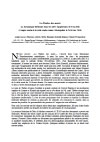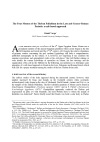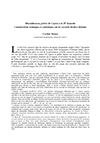Thebes
« La Thèbes des morts. La dynamique thĂ©baine dans les idĂ©es Ă©gyptiennes de l’au-delĂ »
ENiM 8, 2015, p. 37-66.
 Le 24 février 2015 s’est tenue à Montpellier une table ronde rassemblant les membres du projet « La Thèbes des morts » inscrit dans le cadre du LabEx Archimède. Les participants ont exposé le bilan d’un an de travail et, chacun dans son domaine a montré comment, au cours du Ier millénaire avant J.-C., s’est manifestée la dynamique de la pensée thébaine dans le domaine funéraire. On trouvera ici un résumé des communications.
Le 24 février 2015 s’est tenue à Montpellier une table ronde rassemblant les membres du projet « La Thèbes des morts » inscrit dans le cadre du LabEx Archimède. Les participants ont exposé le bilan d’un an de travail et, chacun dans son domaine a montré comment, au cours du Ier millénaire avant J.-C., s’est manifestée la dynamique de la pensée thébaine dans le domaine funéraire. On trouvera ici un résumé des communications.
 On February 24th 2015, in Montpellier a workshop was held gathering the members of the project “La Thèbes des morts” as part of the LabEx Archimède. The participants have presented an overview of their work after one year, each of them, in their field, demonstrating how, during the Ist millenary B.C, the Theban way of thinking has shown in the funerary field. A summary of each of these communications can here be found .
On February 24th 2015, in Montpellier a workshop was held gathering the members of the project “La Thèbes des morts” as part of the LabEx Archimède. The participants have presented an overview of their work after one year, each of them, in their field, demonstrating how, during the Ist millenary B.C, the Theban way of thinking has shown in the funerary field. A summary of each of these communications can here be found .
 Consulter cet article (47618) -
Consulter cet article (47618) -  Télécharger cet article au format pdf (22676)
Télécharger cet article au format pdf (22676)
« The Four Montus of the Theban Palladium in the Late and Graeco-Roman Periods: a cult-based approach »
ENiM 14, 2021, p. 315-322.
 L’étude traite de quelques méthodologies et d’approches possibles concernant le culte de Montou dans les temples du palladium thébain (Médamoud, Karnak Nord, Ermant, Tôd) dans les époques tardives, ptolémaïque et romaine. Un bref résumé de l’histoire et de l’état actuel de la recherche est également inclus.
L’étude traite de quelques méthodologies et d’approches possibles concernant le culte de Montou dans les temples du palladium thébain (Médamoud, Karnak Nord, Ermant, Tôd) dans les époques tardives, ptolémaïque et romaine. Un bref résumé de l’histoire et de l’état actuel de la recherche est également inclus.
 The study deals with some methodological possibilities and suitable approaches regarding the cult of Montu in the temples of the Theban Palladium (Medamud, North Karnak, Armant, Tod) during the Late, Ptolemaic and Roman Periods. A brief overview of the research history and the current state of research are also included.
The study deals with some methodological possibilities and suitable approaches regarding the cult of Montu in the temples of the Theban Palladium (Medamud, North Karnak, Armant, Tod) during the Late, Ptolemaic and Roman Periods. A brief overview of the research history and the current state of research are also included.
 Consulter cet article (27065) -
Consulter cet article (27065) -  Télécharger cet article au format pdf (13652)
Télécharger cet article au format pdf (13652)
« Disoukhonsou, prĂŞtre de Coptos Ă la 25e dynastie. ConsidĂ©rations techniques et symboliques sur les cercueils bivalves thĂ©bains »
ENiM 15, 2022, p. 181-212.
 Le cercueil égyptien conservé au musée Jacquemart-André appartient à un certain Disoukhonsou, prêtre de Coptos à la 25e dynastie. Son étude et sa restauration ont fourni l’occasion de le replacer au sein de la production des cercueils bivalves, caractéristiques des 25e-26e dynasties. Le cercueil bivalve est conçu, techniquement et symboliquement, comme une enveloppe-cocon, à l’instar de l’enveloppe de cartonnage de l’époque libyenne qu’il remplace progressivement. Il présente une particularité technique dérivant des cartonnages : l’application d’une toile enveloppante support du décor, recouvrant toute la surface extérieure, englobant cuve et couvercle en un tout. Il est proposé de considérer l’enveloppement intégral de toile à l’extérieur du cercueil comme l’un des critères propres aux cercueils bivalves thébains des 25-26e dynasties. S’il est possible que la momie ait été mise en place avant la réalisation du décor, une hypothèse différente est ici défendue, privilégiant un autre enchaînement des étapes de réalisation : le cercueil était entièrement réalisé et décoré, avant d’être rouvert en découpant la toile pour y insérer la momie, puis refermé. Cette re-fermeture matérielle s’accompagnait probablement d’une réparation symbolique, tout aussi efficiente dans la pensée égyptienne pour rétablir l’herméticité recherchée. L’étude réalisée, principalement sur les cercueils du musée du Louvre, expose les éléments réunis pour étayer ces hypothèses et invite les chercheurs à multiplier l’examen d’autres cercueils afin de les enrichir et discuter.
Le cercueil égyptien conservé au musée Jacquemart-André appartient à un certain Disoukhonsou, prêtre de Coptos à la 25e dynastie. Son étude et sa restauration ont fourni l’occasion de le replacer au sein de la production des cercueils bivalves, caractéristiques des 25e-26e dynasties. Le cercueil bivalve est conçu, techniquement et symboliquement, comme une enveloppe-cocon, à l’instar de l’enveloppe de cartonnage de l’époque libyenne qu’il remplace progressivement. Il présente une particularité technique dérivant des cartonnages : l’application d’une toile enveloppante support du décor, recouvrant toute la surface extérieure, englobant cuve et couvercle en un tout. Il est proposé de considérer l’enveloppement intégral de toile à l’extérieur du cercueil comme l’un des critères propres aux cercueils bivalves thébains des 25-26e dynasties. S’il est possible que la momie ait été mise en place avant la réalisation du décor, une hypothèse différente est ici défendue, privilégiant un autre enchaînement des étapes de réalisation : le cercueil était entièrement réalisé et décoré, avant d’être rouvert en découpant la toile pour y insérer la momie, puis refermé. Cette re-fermeture matérielle s’accompagnait probablement d’une réparation symbolique, tout aussi efficiente dans la pensée égyptienne pour rétablir l’herméticité recherchée. L’étude réalisée, principalement sur les cercueils du musée du Louvre, expose les éléments réunis pour étayer ces hypothèses et invite les chercheurs à multiplier l’examen d’autres cercueils afin de les enrichir et discuter.
 The Egyptian coffin kept in the Jacquemart-André museum belongs to a certain Disoukhonsou, priest of Coptos in the 25th Dynasty. Its study and restoration provided the opportunity to place it back within the production of bivalve coffins characteristic of the 25-26th Dynasties. The bivalve coffin is technically and symbolically designed as a cocoon-shell, much like the Libyan cartonnage case it gradually replaces. It shows a technical peculiarity deriving from cartonnage cases: the application of an enveloping linen for the decoration, covering the entire exterior surface, encompassing the box and lid in a whole. It is proposed to consider the linen wrap on the outside of the coffin as one of the criteria specific to Theban bivalve coffins of the 25-26th Dynasties. If the mummy may sometimes have been put in place before decorating, a different hypothesis is defended here, favoring another sequence of crafting steps: the coffin was entirely made and decorated, before being reopened by cutting the canvas to insert the mummy, then closed again. This material re-closure was probably accompanied by a symbolic repair, just as effective to the Egyptian mind-frame in order to recreate the sought-after hermeticity. The study carried out, mainly on the Louvre coffins, describes the elements gathered to support these hypotheses and invites researchers to examine other coffins in order to enrich and discuss them.
The Egyptian coffin kept in the Jacquemart-André museum belongs to a certain Disoukhonsou, priest of Coptos in the 25th Dynasty. Its study and restoration provided the opportunity to place it back within the production of bivalve coffins characteristic of the 25-26th Dynasties. The bivalve coffin is technically and symbolically designed as a cocoon-shell, much like the Libyan cartonnage case it gradually replaces. It shows a technical peculiarity deriving from cartonnage cases: the application of an enveloping linen for the decoration, covering the entire exterior surface, encompassing the box and lid in a whole. It is proposed to consider the linen wrap on the outside of the coffin as one of the criteria specific to Theban bivalve coffins of the 25-26th Dynasties. If the mummy may sometimes have been put in place before decorating, a different hypothesis is defended here, favoring another sequence of crafting steps: the coffin was entirely made and decorated, before being reopened by cutting the canvas to insert the mummy, then closed again. This material re-closure was probably accompanied by a symbolic repair, just as effective to the Egyptian mind-frame in order to recreate the sought-after hermeticity. The study carried out, mainly on the Louvre coffins, describes the elements gathered to support these hypotheses and invites researchers to examine other coffins in order to enrich and discuss them.
 Consulter cet article (27647) -
Consulter cet article (27647) -  Télécharger cet article au format pdf (9434)
Télécharger cet article au format pdf (9434)
ENiM 18 - 2025
4 article(s) - 11 mars 2025.
ENiM 1 à 18 (2008-2025) : 223 articles
4 023 075 téléchargements
8 342 004 consulations.
Index des auteurs

Mots clés

Derniers articles : 
Robert Steven Bianchi
Duplication and Continuity
(ENiM 18, p. 13-36 — 11 mars 2025) 
Frédéric Mougenot
Rénénoutet à la porte de la maison
(ENiM 18, p. 1-12 — 29 janvier 2025) 
CENiM - Mise en ligne des volumes Ă©puisĂ©s : 
 Anne-Sophie von BOMHARD DĂ©cans Ă©gyptiens, CENiM 23, Montpellier, 2020 — (2020)
Anne-Sophie von BOMHARD DĂ©cans Ă©gyptiens, CENiM 23, Montpellier, 2020 — (2020) 
 Jean-Claude Grenier L'Osiris ANTINOOS, CENiM 1, Montpellier, 2008 — (26 dĂ©cembre 2008)
Jean-Claude Grenier L'Osiris ANTINOOS, CENiM 1, Montpellier, 2008 — (26 dĂ©cembre 2008) 
TDENiM - Mise en ligne des volumes Ă©puisĂ©s : 
 Twitter
Twitter 3617342 visites - 11009 visite(s) aujourd’hui - 85 connecté(s)
© ENiM - Une revue d’égyptologie sur internet
Équipe Égypte Nilotique et Méditerranéenne - UMR 5140 - « Archéologie des Sociétés Méditerranéennes » (Cnrs) - Université Paul Valéry - Montpellier III
























 Contact
Contact
 Abonnez-vous !
Abonnez-vous ! Équipe Égypte Nilotique et Méditerranéenne
Équipe Égypte Nilotique et Méditerranéenne UMR 5140 « Archéologie des Sociétés Méditerranéennes » (Cnrs)
UMR 5140 « Archéologie des Sociétés Méditerranéennes » (Cnrs) Université Paul Valéry - Montpellier III
Université Paul Valéry - Montpellier III